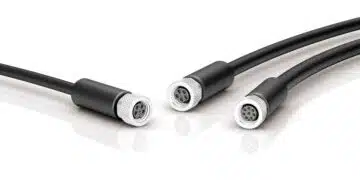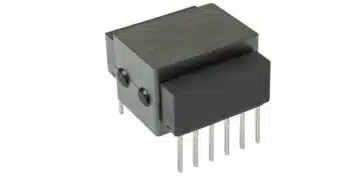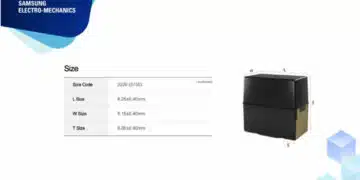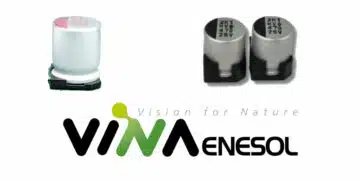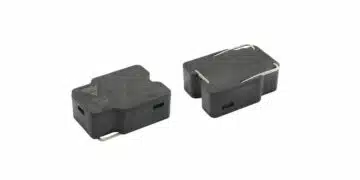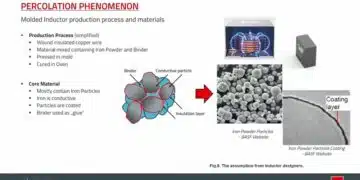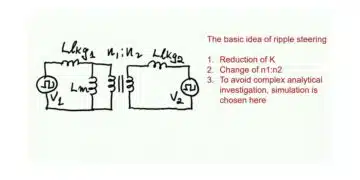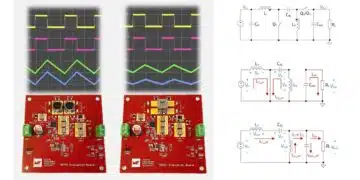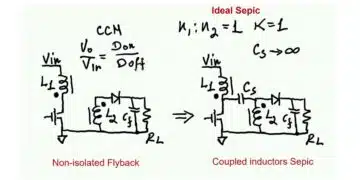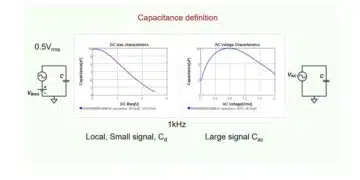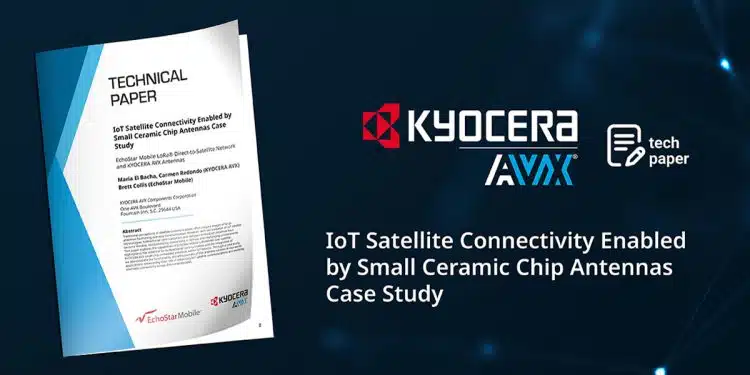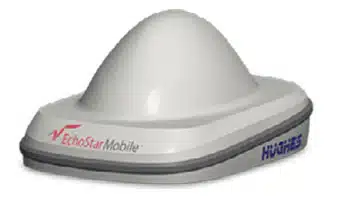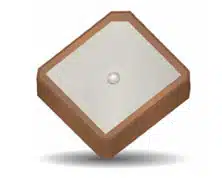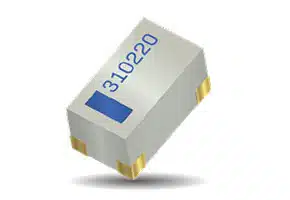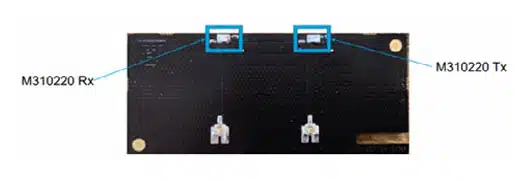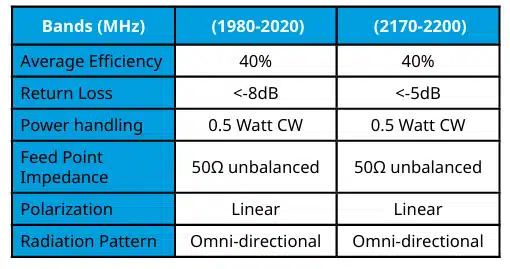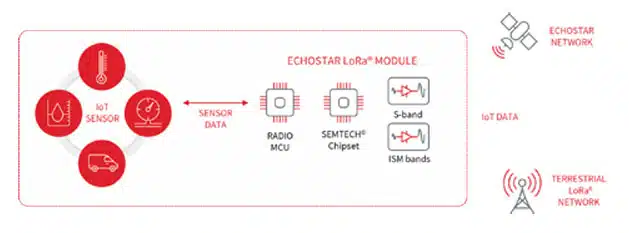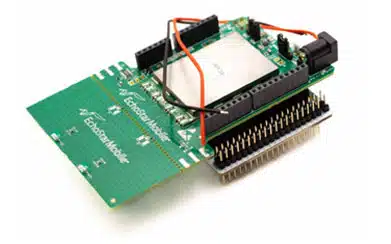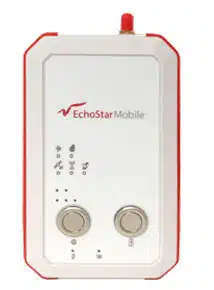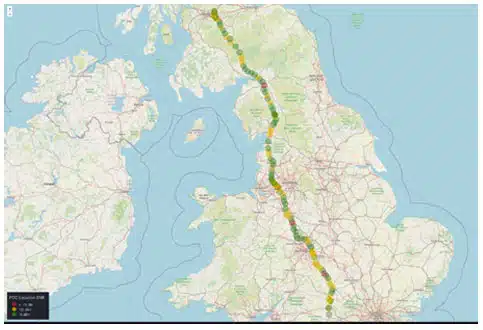This article written by Maria El Bacha & Carmen Redondo KYOCERA-AVX Corporation and Brett Collis, EchoStar Mobile presents a case study how IoT satellite connectivity is enabled by small ceramic chip antennas.
Abstract
Traditional perceptions of satellite communications often conjure images of large antennas facilitating one-way communication. However, with the evolution of IoT satellite technologies, bidirectional communication and compact embedded antennas have become feasible, revolutionizing connectivity in remote and challenging environments.
This paper explores the capabilities of EchoStar Mobile LoRaWAN® over satellite, highlighting the potential for bi-directional communication and the integration of KYOCERA AVX small chip embedded antennas within IoT devices. Through a case study, we demonstrate the functionality and effectiveness of this antenna solution in real-world applications, showcasing their role in advancing IoT satellite communications and enabling seamless connectivity across diverse landscapes.
IoT Satellite Connectivity
The Internet of Things (IoT) has revolutionized industries by enabling real-time data collection, transmission, and analysis through interconnected low-power devices. Despite these advancements, traditional terrestrial networks often face challenges in reaching remote or inaccessible areas, prompting the need for alternative solutions.
Satellite communication emerges as a reliable and robust option to extend IoT connectivity to these regions, offering unique advantages such as global coverage, scalability, and resilience in challenging environments. With advancements in satellite technology, particularly in low-earth orbit (LEO) and geostationary earth orbit (GEO) satellite constellations, satellite-based IoT connectivity has become more accessible and cost-effective than ever before.
This paper explores the landscape of IoT satellite connectivity, with a focus on the EchoStar Mobile LoRa® Network and the integration of satellite communication in IoT devices and platforms. Through a comprehensive analysis of various antenna solutions for the S-band and a real case study, this paper aims to provide valuable insights into the role of satellite communication in advancing the capabilities and reach of IoT ecosystems, unlocking the full potential of this technology for seamless, global IoT connectivity.
Echostar Mobile LoRa® Direct-to-satellite Connectivity
EchoStar Mobile revolutionizes IoT connectivity across Europe by offering extensive LoRa® coverage through its satellite network. Operating in the S-band, the satellite boasts impressive uplink and downlink capacities of 100 Mbit/s, ensuring robust communication channels. Leveraging this high-power satellite, licensed S-band and the sensitivity of the LoRa® and LR-FHSS modulations, even small antennas on IoT modules achieve exceptional performance, receiving signals in conditions where traditional ISM services struggle.
This unique synergy significantly reduces terminal size and leveraging on LoRaWAN® protocol minimize power consumption, enabling battery powered devices to operate for extended periods (years) without needing replacement. EchoStar Mobile’s satellite IoT system operates on the S-band 5G frequency: n256 band from 1980 to 2010 MHz in uplink direction and from 2170 to 2200 MHz in downlink . This frequency band is commonly used for mobile and satellite communications, as well as radar systems for weather tracking and marine applications.
The S-band offers significant resistance to signal fading caused by adverse weather conditions like rain, snow, and ice, ensuring reliable satellite connectivity even during changing atmospheric conditions experienced in Europe. This cutting-edge network provides direct-to satellite IoT connectivity, serving diverse sectors such as agriculture, environmental monitoring, and asset tracking, among others.
KYOCERA AVX Antenna Solutions for the S-band
Antennas designed for Satellite IoT inherently involve complexity, requiring compact form factors and strict adherence to satellite communication standards. KYOCERA AVX addresses this challenge by offering a wide range of antenna solutions: from high-performance antennas, suited for the most demanding conditions, to small embedded antennas, designed specifically for IoT devices.
Premium Solution: Circular Polarized External Antennas
External antennas with high directivity and circular polarization are the optimal solutions for satellite communications. KYOCERA AVX has developed the S-band high-gain antenna with Right-Hand Circular Polarization (RHCP) for the Hughes 4500Terminal. The Hughes 4500 terminal delivers Mobile Satellite Services with affordable data connectivity for applications in connected vehicles, industrial, fisheries, resource extraction, environmental monitoring, and smart grid monitoring among others.
Its low standby power consumption enables seamless end-to-end IP connectivity for sites that are off the grid. Specifically designed for power challenged locations relying on solar-battery arrays with sensitive power budgets, the Hughes 4500 terminal is an ideal solution.
Medium Range Solution: Circular Polarized Patch Antennas
Patch antennas are recognized for their circular polarization and low-profile design, making them ideal for embedding into devices. Widely used in satellite communications such as GPS or GNSS systems, they provide an effective solution for compact and integrated applications.
Ceramic patch antennas offer the smallest sizes, as the high permittivity of the material allows to shrink the dimensions. On the other hand, the weight is typically larger than other types of antennas. Another option with lighter weight but larger dimensions are the “air-spaced patches”. They are called “air-spaced” as they don’t have any material below: for example, a stamped size of the patch is larger but, on the other side, components can be mounted below the antenna, offering an interesting solution for certain devices.
Overall, patch antennas tend to have a large size for embedded solutions. In Figure 2 an S-band ceramic patch antenna of dimensions 18 x 18 x 4 mm is shown. The KYOCERA AVX PN 9003329 covers the frequencies 1980-2020 MHz and PN 9003330 covers 2170-2200 MHz, allowing to have one patch for Tx and another one for Rx.
Efficient Solution: Small Ceramic Chip Antennas
When talking about IoT devices, the image in mind is small devices. As mentioned in the previous section, even if the patch antennas are an interesting solution for embedding inside the devices, the cost and size don’t make them the most efficient solution for IoT.
From KYOCERA AVX’s large antenna portfolio of embedded antennas, ProEsys, world leader in IoT solutions via GEO/LEO satellite, has designed a solution for EchoStar Mobile LoRa® connectivity using the small ceramic chip antenna M310220 tuned for the S-band.
The antenna’s size is only 3.00 x 1.50 x 1.08 mm3 and it can be easily integrated into any board thanks to its small form factor and SMT properties.
KYOCERA AVX Antenna Solutions for the S-band
Ceramic chip antennas are narrow band due to the high permittivity of the material. The design proposed by ProEsys is a system using two M310220 antennas: one used for the Tx frequencies and the other antenna used for the Rx frequencies, as shown on the evaluation board in Figure 4.
The frequency covered for each antenna and the RF performance obtained are shown in Table 1. Compared to patch antennas, ceramic chip antennas provide linear polarization instead of circular polarization. On the other hand, these antennas embedded on the PCB provide omni directional radiation patterns compared to the high directivity of the patch antennas.
For IoT devices that are not facing the sky at all moments, these characteristics can be beneficial for the overall performance (note that although linear polarized antennas may suffer from 3dB losses compared to circular polarized patch antennas when used to receive a circular polarized signal, the linear antenna’s omnidirectional radiation pattern will allow the device to have almost constant performance, no matter how is the device oriented).
Relying on their narrow band characteristics, the Tx/Rx system constitutes a natural filter that highly improves the reception of the device by having good isolation between the antennas. This configuration also helps to collect a minimal amount of noise, allowing very efficient reception of the satellite signals.
All these characteristics prove that the ceramic chip antennas M310220 are an excellent option for IoT devices connected to EchoStar Mobile LoRa® direct-to-satellite network, as they take minimum space on the PCB and have excellent performance.
Echostar Mobile EM2050-EVK
The EchoStar Mobile evaluation kit EM2050-EVK allows faster time-to-market by having customers use the evaluation kit as a starting point in their design or as proof of concept. It serves as a flexible platform, enabling effortless integration with a diverse range of sensors and applications for real world testing within the network environment. The EM2050-EVK contains all the key components to build an IoT solution:
- It uses the plug-and-play module EM2050, which offers dual-mode connectivity (terrestrial 868/915MHz and S-band satellite), facilitating the integration with existing networks. See the block diagram of the module in Figure 5.
- It includes a detachable PCB with the KYOCERA AVX M310220 S-band antennas, so the evaluation kit is ready to communicate. By simply integrating the specific sensors and battery, and enclosing them in a box, the solution can be tested in any outdoor scenario in few hours with a minimum effort.
Case Study: Tracking the Path from Scotland to Oxford
EchoStar Mobile has carried out several field tests to prove the performance of the innovative solution based on EM2050 modules and own constellation of satellites In this case study, the EchoStar Mobile sensor device (Figure 7) integrating an EM2050 Module with a GPS tracker has been used for tracking the route from Scotland to Oxford.
The device was tested in real-life scenarios. It was placed within a car dashboard traveling from Scotland to Oxford. As seen in Figure 8, it passes through all types of roads: urban, rural etc. and it was connected all along the way. Some signals are stronger than others, but all succeeded in connection and communication with the satellite using just a chip omnidirectional antenna embedded into device and with tough conditions of mobility scenario.
The number of applications that can benefit from EchoStar Mobile LoRa® direct-to-satellite network go from transportation and tracking of mobile assets to real-time sensors in remote areas, for example, alerting of weather conditions or wildfires, where the satellite connectivity will expand the connectivity possibilities where the terrestrial networks are not reachable.
Conclusion
In conclusion, this paper has provided insight into the evolution of satellite communications, particularly in the context of IoT technologies, thereby opening up new possibilities for connectivity in remote and challenging environments.
We have examined the capabilities of the EchoStar Mobile LoRa® over satellite network, emphasizing different antenna solutions from KYOCERA AVX, from premium external antennas to small references chip embedded antennas within IoT devices.
Furthermore, through a case study, we have showcased the functionality and effectiveness of KYOCERA AVX small chip antennas M310220 in the S-band for the EchoStar Mobile LoRa® direct to-satellite network, demonstrating the versatility and reliability of this antenna solution in real-world applications.


